Landscape Lighting
Everything You Need to Know
When it comes to the exterior of a homeowner’s property, the lighting is often overlooked. Lake Mary, Florida homeowners will generally focus more on improving the landscape itself, from flower beds and gardens to shrubbery and trees, not to mention hardscape and water features, from patios to ponds. However, one could argue that your landscape lighting is just as important a component to your Longwood, Florida property as anything else — if not more so.
The following is an in-depth guide that will inform you about what landscape lighting is, how you can benefit from it, how to best implement it, and much more. Essentially, we’ve laid out everything you need to know about landscape lighting and then some.
Topics
- Types of Landscape Lighting
- Landscape Lighting Terms
- Landscape Lighting Benefits
- Landscape Lighting Effects
- Planning your Landscape Lighting
- Matching Landscape Lighting to Other Fixtures
- Saving Money on Your Electric Bill
- Why use Low-Voltage Lights
- Installing and Controlling Landscape Lights
- Landscape Lighting FAQ's
- Synder's Landscapes Difference
Types of Landscape Lighting
There’s a lot more to lighting your property than just installing a couple of lights to the sides of your home. In fact, there are countless ways that you can light your property using a variety of different lighting fixtures. The following are some of the common types of landscape lighting that you might want to implement into your own landscape:
- Spotlights. Spotlights provide controlled beams of intense light that allow you to highlight focal points of your landscape, such as statues or other features of interest. They will light up the entire feature, but because they are so controlled, they won’t overlight the surrounding space.
- Floodlights. Floodlights provide a significant amount of light and are generally meant for one purpose only — to cast light over a large area. For example, you can install a floodlight above the garage so that you can see where you’re going when you drive up your driveway. Floodlights can also be used in different places around the house to ward off potential intruders. Floodlights are often equipped with motion sensors to avoid overwhelming the property with harsh lighting all night long.
- Exterior Lights. Exterior lights refer to fixtures attached to the exterior of the house, such as wall fixtures that flank the front door or a pendant light that hangs from the porch above the entryway. Exterior lights can be used to make the entryway safer, highlight certain features on your home’s exterior, or simply add light for functional reasons; for example, so that you can read on your porch at night.
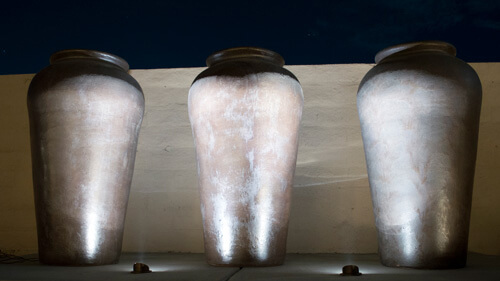 Uplights. Uplighting is a type of lighting that only serves as an aesthetic function. Most uplighting is accomplished by installing
Uplights. Uplighting is a type of lighting that only serves as an aesthetic function. Most uplighting is accomplished by installing
small lights in the ground that point upwards (hence the name). You can highlight different landscaping features, such as trees and statues, using uplighting, thereby creating a dramatic look that draws the eye immediately.- Zone Lighting. Setting up your landscape lighting using zone lighting will allow you to have control over different zones. For example, maybe you have your home’s exterior lighting designated in one zone and the lighting in your firepit area in another. You can then turn one zone off while leaving the other zone on. The zone system simply provides more control over your outdoor lighting schemes.
- Motion Detector Lighting. Motion detectors are used so that you don’t waste energy lighting areas that don’t need to be lit all night long. They’re often used for floodlights, but they can also be used for pathway lights or for the lights at your front door. This ensures that you don’t disturb your household or your neighbors because there’s too much light coming from your property at night.
- Decorative Lighting. Decorative lighting is lighting meant purely to boost the curb appeal of your landscape. For example, the use of underwater light fixtures in your pond, or the use of string lights above your deck or patio space.
- Landscape Lighting. Landscape lighting includes functional lighting, such as pathway lighting that lights up the walkway to your home or to other features on your property, such as your pool or your firepit. Lights can also be installed into walls and steps to help show the way while also highlighting the features themselves.
- Mood Lighting. Mood lighting involves setting up lights to create specific moods. For example, using diffused lighting or certain types of fixtures that add to an ambiance that you’re going for. The use of different colored lights can also help establish a certain mood.
- Tree and Shrub Lighting. There are many ways that you can highlight your trees and shrubs. In addition to using uplighting, you can also lights to “wash” the space you want to light, thereby highlighting several shrubs or trees at a time.
Landscape Lighting Terms
Knowing the basic lighting lingo will make it easier to talk to landscape lighting professionals so that you can communicate what you’re looking for and understand what you’re being told about your property’s lighting capabilities and limits. Not to mention that knowing some of the following lighting terms can help make it easier to understand lighting guides such as this one!
Transformer
The transformer is what provides power to your landscape lighting. It plugs into a GFCI-protected outdoor outlet and reduces your house current from 120 volts to 12. Almost all transformers come equipped with a 24-hour timer that allows you to set when the lights turn on and off automatically.
Low-Voltage Electrical Cable
This underground cable runs from the transformer to each fixture in your landscape lighting system.
Accent Lighting
Accent fixtures are specialty fixtures that don’t serve as a major function of your landscape lighting. Instead, accent fixtures compliment your main lighting scheme with uplights, wall-wash fixtures, spotlights, and more that add visual interest and create a more balanced aesthetic.
Task Lighting
Unlike accent lighting, task lighting has a very specific purpose. For example, pathway lights are meant to light your pathways. Their function goes beyond the aesthetic.
Diffused Light
Diffused light is light that is diffused through refraction by the means of frosted lenses or by reflection. It scatters light to create a softer-edged beam.
Light Pollution
Light pollution refers to excessive light that spreads to unwanted areas. For example, if you line your property with floodlights and keep them on all night long, your neighbors are likely to consider that light pollution.
Brightness
Brightness is a subjective measurement of a light source that includes the intensity of the light and the luminance.
Luminance
Luminance refers to the light projected from a lamp source or the light that’s reflected from a surface, which is measured at a point in space.
Visual Comfort
Visual comfort refers to the absence of visual discomfort that might be caused by high levels of brightness or glare.
See What Our Clients Have to Say
Landscape Lighting Effects
You can add a unique look to your landscape through the way that you use your lighting. The following are a few visually stunning effects that you can create through the use of your landscape lighting:
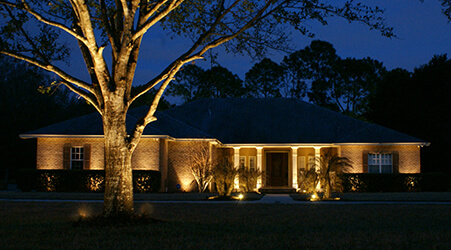 Silhouetting
Silhouetting
Silhouetting helps to add drama to your lighting scheme. All it requires is that you place a focused light source, such as a spotlight, behind one of your landscaping features, such as a small tree, and towards where the main vantage point will be. This will cast the feature into a beautiful silhouette that will draw the eye.
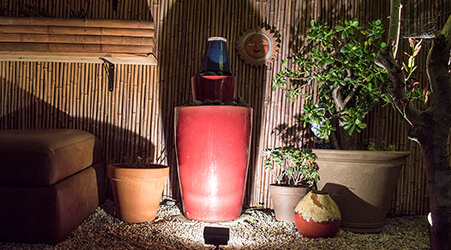 Shadowing
Shadowing
Shadowing works best when you have landscape features that are situated near a wall. To perform the shadowing effect, you’ll want to install a light source between the feature in question and the main vantage point, aiming the light at the feature. The wall behind the feature will then catch the shadow being created, which adds a dynamic layer to your lighting scheme.
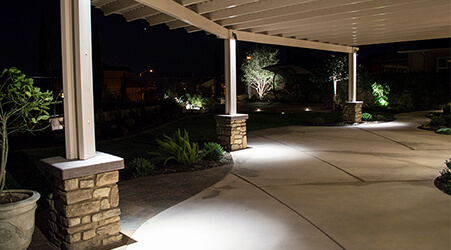 Moonlighting
Moonlighting
Moonlighting is like a reverse of uplighting. It’s typically used for taller trees. The way it’s done is that the lights are affixed to a branch near the top of the tree and aimed downwards. The light then washes the branches and ground below the tree in light, thereby mimicking the light of the moon in a stronger way.
 Grazing
Grazing
Grazing is an effect that involves installing fixtures close to a flat surface and aiming it directly up or down. Grazing effects are often done with hardscaping features as they tend to create a dramatic tension between light and shadow and can help to bring out the texture of brick or stone walls in particular. The look has a luxurious feel to it, which is why the grazing effect is often employed by upscale restaurants and hotels, but it can certainly be used on residential properties as well!
Landscape Lighting Benefits
As you’re reading about all of these different lighting fixtures and light effects that you can implement into your landscape lighting scheme, you might be wondering, “what’s the point of doing all of this?” There are actually many points for creating a balanced and varied landscape lighting system. The following are the four major benefits that you’ll enjoy from investing in your landscape lighting:
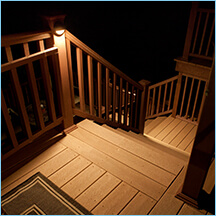
Home Safety
At the very least, exterior lighting is necessary to maintain the safety of your property. Attempting to walk up your sidewalk without being able to see at night can be downright dangerous, especially if it’s not a straight shot to your front door. The inability to see can cause you to trip over landscape features, which could potentially cause injury. The same goes for your driveway — a lack of lighting could cause you to drive into your garage door at night if you have a garage, which could cause injury or property damage. Additionally, you won’t want to be liable for any lawsuits should guests hurt themselves navigating your property in the dark.

Home Security
Good landscape lighting will also help improve your home security. First of all, potential thieves or intruders are much less likely to sneak around on your property if it’s lit. The darker your property is, the easier it is to hide in the shadows and to make their way to your house unseen. Secondly, good lighting will allow you to see every part of your property from your home, and it will allow neighbors to see if anyone is sneaking around as well. If you install spotlights with motion detectors, you can also scare away potential intruders the moment they move into the vicinity of those lights and they turn on, immediately picking them out of the dark for the world to see.
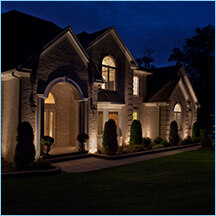 Functionality
Functionality
Besides safety and security, good lighting simply makes your property easier to use. For example, fumbling with your keys at your front door because you don’t have proper lighting every night is going to get aggravating very quickly. Additionally, odds are you might want to actually use the exterior of your home once in a while even when it’s dark out. Exterior lighting will allow you to sit out on your porch or deck without being covered in darkness and will allow you to host social gatherings around your firepit or out on your patio.
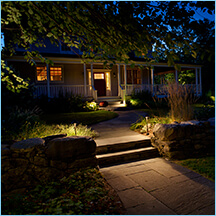
Curb Appeal
Last, but not least, a good landscape lighting scheme can help boost your property’s curb appeal. A lot of homeowners understand the importance of curb appeal, but don’t realize that the concept extends past the daytime. If you can’t see the landscape you’ve put so much effort into beautifying, then what was the point? Effective lighting will help highlight the features you’re most proud of, thereby helping you to maintain your property’s curb appeal throughout the night.
Planning your Landscape Lighting
Looking over all of the different lighting fixtures that are available to use and all the different ways to light your landscape, it might seem a little overwhelming — especially when you’re trying to keep in mind safety, security, functionality and curb appeal all at once. The easiest way to begin planning your landscape lighting is by breaking it down into different sections of your property. The following are four of the main areas you’ll want to focus on and what you should consider when planning your outdoor lighting for these areas:
 Lighting your Home’s Entryway
Lighting your Home’s Entryway
The entryway to your home should be a focal point, both for aesthetic reasons and for functional reasons — if you’re coming home or visiting, you won’t want to think twice about which way to go in order to get to the front door, after all. You’ll want to create a wide pool of light that illuminates the entry. Typically, either a ceiling-mounted fixture or a pair of wall-mounted fixtures that flank the door or entryway will do, although, for larger entry spaces, you may want to go with both. As for the style of fixtures, this depends on the style of your home and personal taste — just remember that it does matter to the visual design of your entry space (and guests will see these lights up close).
 Lighting Stairways and Pathways
Lighting Stairways and Pathways
Lighting your pathway and stairs is necessary to the safety of your property. However, you want to be careful not to overlight these areas as this can result in light pollution. Pathway lighting tends to do the trick quite well since they will light up the path but won’t spill light upwards due to their caps. You can also use post lanterns if you want the fixture to stand out. If you have a lot of trees or shrubs flanking your pathways, you could also choose to use downlighting or moonlighting to light up your pathways. When it comes to stairs, you can mount fixtures to the posts or even install small LED lights into the steps themselves, which also works well for short steps throughout the pathway.
 Lighting Your Deck and Patio
Lighting Your Deck and Patio
With the deck and patio, one of your priorities (besides ensuring that it’s safe to use at night) should be to create a certain atmosphere that makes it comfortable for people to use, especially if you host a lot of friends and family for get-togethers. There are many ways you can go about this. String lighting wrapped around your railings or strung above your deck or patio can provide a charming, yet inviting atmosphere. LED tape lights are an effective and elegant way to light the space and offer a more polished feel. They’re also extremely flexible and can be placed on the underside of steps and deck rails. They can also be used to define various edges and transitions. For decks and patios built as an extension of your house, wall fixtures can be quite useful as well.
 Lighting your Garage and Driveway
Lighting your Garage and Driveway
With the deck and patio, one of your priorities (besides ensuring that it’s safe to use at night) should be to create a certain atmosphere that makes it comfortable for people to use, especially if you host a lot of friends and family for get-togethers. There are many ways you can go about this. String lighting wrapped around your railings or strung above your deck or patio can provide a charming, yet inviting atmosphere. LED tape lights are an effective and elegant way to light the space and offer a more polished feel. They’re also extremely flexible and can be placed on the underside of steps and deck rails. They can also be used to define various edges and transitions. For decks and patios built as an extension of your house, wall fixtures can be quite useful as well.
Once you’ve planned out the lighting for these four areas, you can fill in the landscape with lighting that highlights specific features, such as flowers, bushes, trees, statues or water features. Make sure you choose what you want your focal points to be in the different parts of your property so that your lighting design doesn’t clash. Additionally, consider not just the view from the road, but also the view from inside your home.
Matching Landscape Lighting to Other Fixtures
When it comes to the goal of improving your property’s curb appeal, you need to make sure that the style of the fixtures you choose go together. It’s just like the interior of a home — you wouldn’t want to decorate your home using elements that clash visually, would you?
The first thing to consider is the style of your house. This is the visual foundation from which to work. You’ll want to consider both the home’s style and the colors of its exterior. For example, if your home is built from brick, then bronze, copper, and brass finished fixtures will compliment it well. For houses that consist of a lot of black and grey tones, chrome, nickel, zinc, and pewter finished fixtures are all good options.
Additionally, if you have a more traditional style home, then traditional fixtures, like lanterns, will work well. For a more contemporary design, more modern fixtures will be more appropriate. If you mix and match your fixtures without regard to your home’s style, your landscape lighting is going to feel messy, even if you were attempting to go for an eclectic look
Saving Money on Your Electric Bill
One of the things that many homeowners probably starting to worry about a bit when you consider all the different areas of your landscape that need lighting for a variety of different purposes is how much all of this will cost — and not just in the short term. While the initial cost of buying and installing fixtures is something most homeowners will gladly invest in order to enjoy the benefits of landscape lighting, the ongoing cost of running your lights that will affect your electric bill for the foreseeable future is probably more of a concern.
Fortunately, there are ways that you can implement the landscape lighting scheme you want without having to pay an arm and a leg for your monthly energy costs. The following are a few tips on how to reduce your landscape lighting system’s energy use to help keep your electric bills from soaring

Avoid Incandescent Bulbs
Incandescent bulbs are some of the more inefficient bulbs on the market. Instead, use CFLs (compact fluorescent lights) or LEDs. CFS are four times as efficient as incandescents, while LEDs are ten times as efficient. Not only do LEDs use a fraction as much energy as standard incandescent bulbs, they last much longer too -- as much as 50,000 hours, whereas incandescent bulbs only last around 1,200 hours. Although initially more expensive, you'll save a lot of money long term when you use LEDs.
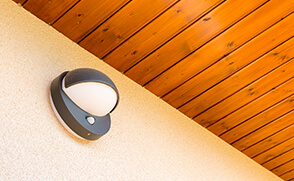
Use Light Sensors
Light sensors will automatically turn your outdoor lighting on when the sun sets and back off when it gets light out, thereby reducing the amount of energy that's wasted because your lighting remained on even when the sun was up.

Use Motion Sensors
Use motion sensors for lights that aren't meant for aesthetic purposes and are only there to serve a specific function. This way, the light only turns on when someone is present and the light is needed instead of remaining on all night.
Why use LED Lights
No landscape design is complete without a good lighting scheme; however, you’ll soon find that there are many different options when it comes to lighting. We highly recommend the use of LED lighting no matter what type of lighting scheme we implement due to the following reasons:
- Energy Efficiency – LED lights are around 90 percent more efficient than typical incandescent bulbs. This means that they will greatly reduce your energy bills over the long term.
- High Quality – LED lights produce a clean, white light that will help to boost the curb appeal of your property. They also come with multiple hue and light intensity options. This provides you with more control over your lighting, which can make the use of your walkways and outdoor areas safer at night.
- Durability – LEDs aren’t bulbs, which means that if you run into them while doing yard work, there won’t be the risk that they’ll shatter, leaving broken glass all over your landscape. LED lights are so durable that every fixture comes with a 15-year warranty.
- Long Lasting – Because of how energy efficient the standard LED light is, it’s going to last much longer than traditional bulbs. The average LED light will last upwards of 20,000 hours. Traditional halogen light bulbs have to be replaced every 4,000 hours. This means that using LED lights will help reduce the cost of replacement.
- Reduce Insect Activity – A lot of light bulbs, such as halogen lights, emit UV light. UV light, unfortunately, attracts insects. You’ll want to try and reduce the amount of insect activity in your yard since the more insects are living on your landscape, the more likely they are to make their way inside your home. LED lights do not emit UV light, which means that they will not actively attract more insects.
Want More Lighting Information?
Installing and Controlling Landscape Lights
When it comes to landscape lighting installation, you’ll definitely want to leave it to the professionals. Not only will you have to install your light fixtures in the ground, in hardscaping features (such as steps or walls) and on your house or garage, but you’ll have to wire them properly. In addition to running cables through your landscape, you’ll need to plan out your zone system so that you’ll be able to handle the power load effectively, efficiently and safely.
When it comes to controlling your outdoor lighting, you have several options. For complete control over every aspect of your lighting, you’ll want to use a smart home automation system. This will allow you to control your zones as well as potentially individual lights via an app that you can access remotely on your smartphone. For example, you can turn off lights whenever you want, you can pre-program the times at which your lights turn on and off, and you can even dim lights and control the color of your lights with more advanced systems.
However, if you do not implement such a smart home automation system, then there are a few other methods of control that you can implement. These include the following
Analog Timers
Analog timers are very basic. You just set the times for when you want to turn your lights on and off. While easy to use, it’s worth noting that it doesn’t give you complete control and you’ll have to reset the timer if the power goes off. It also won’t adjust for things like sunsets or daylight savings.
Digital Timers
Digital timers are more advanced versions of analog timers. You’re given more control, which means that you can pre-program your lights to turn on and off at multiple points during the day and night on different days of the week. Digital timers also come with built-in memory in the event of a power outage.
Astronomical Timers
Astronomical timers are more complex in that they use the GPS coordinates of your property’s location to determine exactly when the sun sets and rises to automatically turn your outdoor lights on and off. They also allow you to preprogram on/off times for different days and contain a built-in memory, just like digital timers.
Light Sensors
Light sensors, or photocells, will automatically turn your lights on and off depending on the amount of light they sense outdoors. This means that once it becomes dark enough, it will turn your lights on automatically. The only drawback of this is that the transformer it’s attached to can’t be located in a shady area or else it won’t be able to sense that it’s daytime until sunlight hits it directly.
Control Combination
A control combination basically combines all of the benefits of a digital timer with that of a light sensor to provide more total control.
Chapter 11:
Landscape Lighting FAQs
Now that you've read through the majority of our guide, odds are you have a pretty good idea of what a landscape lighting system consists of and what the benefits of having one are. However, we're willing to bet that you still have a few questions. The following are a few answers to some of the more common landscape lighting questions that you might have:
Do you Provide Free Estimates?
We do. We understand that everybody’s property is unique and that everybody has different landscape lighting needs. We will meet you for a consultation, during which we will evaluate your specific landscape, go over any ideas you have for your lighting scheme, and talk about some of the ideas that we have as well. We will create a customized lighting plan based on this consultation and provide a free estimate.
What areas do you serve?
We can provide outdoor lighting services to most of Central Florida, including Altamonte, Longwood, Lake Mary, Heathrow, Sanford and Winter Park.
Will lighting installation damage my landscape?
One of the reasons that we emphasize the planning stages of a landscape lighting design is to ensure that your existing landscape is disturbed as little as possible. If in the rare event that something is damaged during the installation process, we will make sure to fix it and/or correct the problem.
What happens if an LED lamp burns out?
A lot of things can cause an LED bulb to burn out; however, you shouldn’t expect it to for a long time considering how long LED lights tend to last for. LED bulbs will often burn out as a result of too much voltage, too little voltage, in-rush currents, arcing, load impact, fixture quality, and/or poor installation. These are all preventable as long as your lighting system is properly set up and your fixtures properly installed. Our reputation tends to speak for itself when it comes to the quality of our projects; however, we can come inspect any lights that burn out to determine what the problem is and to fix it, especially if it was an issue having to do with the installation.
What happens if my whole lighting system won't turn on?
This usually results due to problems with the transformer. We can inspect your transformer to determine if this is the case as well as check all of your lines and fixtures. Transformers can also blow as a result of corroded insulation or from a lightning strike.
Do I have to turn my lighting system on and off every night?
You do not. Depending on the type of control device you install onto your transformers, your lighting system can turn on and off automatically or you can preprogram your system to turn on and off when you want it to. You can also divide your landscape lighting into zones so that you can control which lights turn on and off at what times.
How much energy will an outdoor lighting system use?
A lot of different factors play into how much energy your lighting system ends up using, including how many fixtures your landscape uses and what kind of bulbs you are using. For example, the average landscape lighting system uses about 20 light fixtures. If you’re using traditional CFLs or halogen lights, you’ll need three 250 Watt transformers to wire all of your fixtures to your electrical system. Basically, you’ll end up using around 700 Watts on such a system.
However, we use LED lights, which use way less energy. LED lights use roughly seven Watts each. In a 20-fixture system, only a single transformer will be required if you’re using LEDs. The entire system will use roughly 140 Watts. So, when it comes down to it, an LED landscape lighting system will use up 560 Watts less, which is about 80 percent of the energy a traditional halogen or CFL system will use up.
What's the difference between your products and those at big box stores?
One of the major differences between the service we offer and the products available at big box stores is that we customize lighting schemes based on our evaluation of our customers’ properties to determine what kind of lighting fixtures best suit their landscape. When it comes to big box stores, landscape lighting is generally offered in “one-size-fits-all” kids that you can purchase. You’ll also have to install everything yourself, which can be problematic since these kits rarely offer complete instructions.
Big Box store kits do come with installation manuals, but they won’t mention voltage drop calculations, which means that when you install the system yourself, you can expect low voltage at most of your fixtures. This is an issue since it will shorten the life of your bulbs and cause yellow light to be produced at much less intensity than the rated output.
Additionally, don’t be surprised if the kit doesn’t provide clear instructions on how to bury your wires under the driveway or sidewalk. Not to mention that in most big box kits, the fixtures use alligator type clips to attach to the cable, which will cause the connection to corrode over time and cause the fixture to fail.
Essentially, the difference between our product and the product of a big box store in regards to a landscape lighting system is the quality of service we provide. It doesn’t matter how high-quality your fixtures are if they’re not installed properly.
The Snyder’s Landscapes Difference
When it comes to getting the most out of your landscape lighting, you’ll want to make sure that you work with an experienced landscaping company. Here at Snyder’s Landscaping, we have fostered a reputation as one of the most trustworthy and reliable services in Central Florida. When you work with us, you can expect:
Professional Landscape Lighting Design
Not only do we perform an extensive evaluation of each property we work on, we also work closely with every one of our customers to determine what their lighting needs and wants are. This allows us to find the best lighting solutions tailored to your landscape, your needs and your budget.
Professional Guidance
We can answer any questions and concerns that you might have concerning your landscape lighting as well as provide professional advice regarding any ideas or solutions.
Ongoing Maintenance
Not only can you expect high-quality lighting fixtures that are properly installed on your property, but we can provide ongoing maintenance to keep your landscape lighting — as well as your landscape — in good shape for years to come.
To request a free estimate, be sure to contact us at Snyder’s Landscapes to schedule a landscape lighting consultation in the Central Florida area today.
